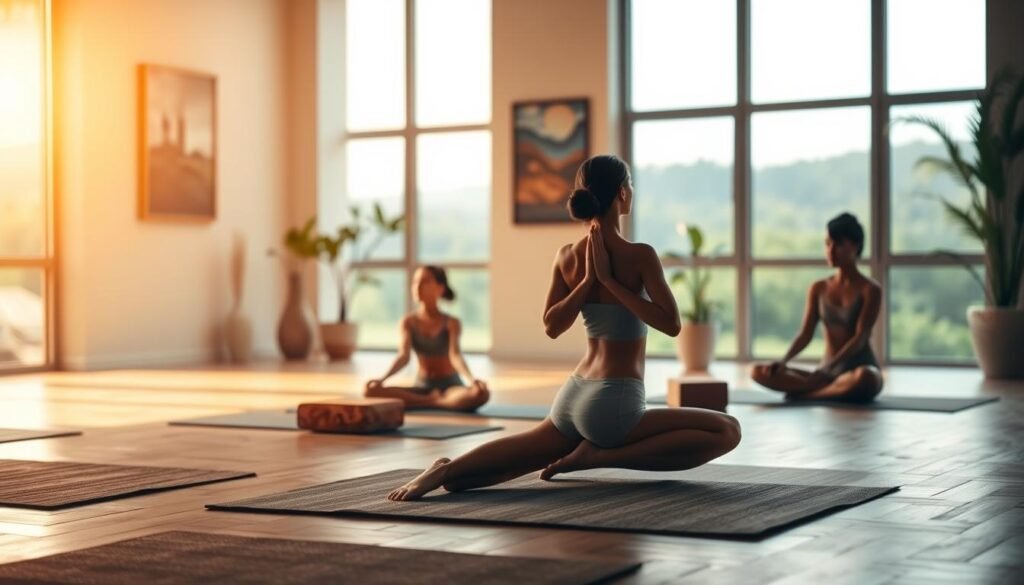Did you know that small daily habits like deep breathing or a brief walk in nature can change how you handle stress? In today’s fast-paced world, self-care relaxation techniques are not just trends. They are key for keeping your mind and body healthy.
This article looks at proven methods like mindfulness, breathing exercises, and spending time in nature. Find out how these simple yet effective strategies can be part of your busy life.
Key Takeaways
- Self-care relaxation techniques reduce stress and improve mental clarity.
- Short practices like deep breathing or mindful walks can be done anywhere.
- Science supports techniques such as progressive muscle relaxation and meditation for better well-being.
- These methods can be tailored to fit personal schedules and preferences.
- Regular use of these techniques builds long-term resilience against daily stressors.
Understanding Self-Care and Its Importance
Self-care is more than just a trend; it’s crucial. Our lives are filled with constant demands, making it key for our well-being. This part looks into how focusing on your health boosts both your body and mind.
Defining Self-Care
“Self-care is any intentional action that preserves or improves one’s health.”
Experts say it’s about taking steps to care for your physical, emotional, and mental health. This can be meditation, exercise, or just taking a break when you’re tired. These actions help avoid burnout and build resilience against daily stress.
The Benefits of Self-Care
- Reduces chronic stress through stress relief tips like deep breathing.
- Boosts immunity by lowering cortisol levels.
- Improves focus and job performance through better emotional regulation.
- Strengthens relationships by enhancing patience and empathy.
How Self-Care Improves Mental Health
Regular self-care strategies fight anxiety and depression. For example:
| Self-Care Action | Mental Health Impact |
|---|---|
| Journaling | Reduces rumination and enhances clarity. |
| Walking in nature | Lowers symptoms of mild depression. |
| Quality sleep routines | Improves emotional stability and memory. |
Studies reveal 75% of adults who practice daily self-care see fewer stress-related illnesses. It’s not selfish to put yourself first—it’s backed by science for thriving in today’s fast world.
The Role of Relaxation in Self-Care
Relaxation exercises are key for keeping our minds and bodies healthy. They help us fight stress and boost our overall health. Techniques like deep breathing or progressive muscle relaxation are very helpful. They are important parts of taking care of ourselves.
Understanding Relaxation Techniques
There are many relaxation techniques to choose from. Some popular ones include:
- Deep breathing exercises
- Guided imagery sessions
- Mindful body scans
Each technique is a relaxation exercise. They help us focus on calmness instead of stress.
The Science Behind Relaxation
“Regular relaxation exercises reduce cortisol by up to 22% after 8 weeks of practice.” – Journal of Behavioral Medicine (2022)
When we relax, our body’s parasympathetic nervous system kicks in. This slows down our heart rate and lowers blood pressure. It tells our brain we’re safe. Studies show this leads to better sleep and emotional balance over time.
Relaxation vs. Stress Management
Relaxation and stress management are different but both important. Relaxation exercises help us find calm right away. Stress management is about handling stress in a bigger way, like managing time or setting boundaries. Using both helps us deal with daily stress better.
Mindfulness Practices for Relaxation
Mindfulness is a simple way to calm your mind and reduce stress. It focuses on the present moment. This helps break anxiety cycles and improves mental clarity.
Research shows even short daily sessions can boost emotional well-being.
Introduction to Mindfulness
Mindfulness means observing thoughts and feelings without judgment. It trains your brain to stay in the present. Harvard Medical School studies show it lowers stress.
Techniques to Cultivate Mindfulness
Here are some effective techniques:
- Body Scan Meditation: Focus on physical sensations from toes to head.
- Mindful Breathing: Count breaths and notice inhale/exhale patterns.
- Mindful Observation: Use senses to focus on everyday objects.
| Technique | Key Steps | Benefits |
|---|---|---|
| Body Scan | Lie down, mentally scan body parts | Relieves muscle tension |
| Mindful Breathing | Focus on breath rhythm | Slows heart rate |
| Mindful Listening | Concentrate on ambient sounds | Enhances focus |
The Impact of Mindfulness on Stress
A 2022 study in the Journal of Clinical Psychology found participants practicing 10 minutes daily reduced cortisol levels by 15% over eight weeks.
Regular mindfulness practice strengthens calmness pathways in the brain. Even short breaks, like mindful breathing at work, are beneficial. Small, consistent efforts build lasting mental strength.
Breathing Exercises for Stress Relief
Breathing exercises are simple yet powerful stress management methods that calm the body and mind. By controlling your breath, you can lower heart rate and reduce cortisol levels. This eases tension instantly.
Deep Breathing Techniques
Master these techniques to combat stress anywhere:
- 4-7-8 Breathing: Inhale for 4 seconds, hold for 7, exhale for 8.
- Box Breathing: Inhale, hold, exhale, and hold again for equal counts (e.g., 4 seconds each).
- Alternate Nostril Breathing: Use fingers to alternate nostrils while inhaling/exhaling.
Diaphragmatic Breathing
Also called belly breathing, this technique engages the diaphragm to fully oxygenate the body. Sit comfortably, place a hand on your stomach, and breathe deeply so your hand rises. Practice daily to enhance relaxation and focus.
| Technique | Steps | Benefits |
|---|---|---|
| 4-7-8 | Inhale (4s) → Hold (7s) → Exhale (8s) | Reduces anxiety, improves sleep |
| Box Breathing | Inhale (4s) → Hold (4s) → Exhale (4s) → Hold (4s) | Boosts focus, lowers blood pressure |
| Alternate Nostril | Block one nostril; inhale/exhale through the other | Enhances mental clarity, balances energy |
Guided Breathing Exercises
Apps like Headspace and Calm offer guided sessions. Search for “guided breathing meditations” to explore free options. Consistency is key—practicing even 5 minutes daily strengthens these stress management methods.
“Breathing techniques can lower stress hormones like cortisol by up to 30% in just 10 minutes.” – Journal of Alternative and Complementary Medicine
Progressive Muscle Relaxation Techniques
Progressive Muscle Relaxation (PMR) is a method of relaxation exercises that fights both physical and mental tension. It was developed by physician Edmund Jacobson in the 1920s. PMR works by tensing and then releasing muscles in a specific order to reduce stress.
What is Progressive Muscle Relaxation?
This technique involves focusing on different muscle groups. You tense them for 5–10 seconds and then relax. This process starts from the feet and goes up, helping you become more aware of your body and calm.
Steps to Perform Progressive Muscle Relaxation
- Start by sitting or lying down and take deep breaths.
- Curl your toes down, hold for a few seconds, and then release.
- Move up to your calves, thighs, glutes, and then to your shoulders and face.
- Notice the difference between feeling tense and feeling relaxed in each area.
Benefits of Muscle Relaxation Techniques
- It helps reduce chronic muscle tension and headaches.
- It can lower your blood pressure and heart rate.
- It improves sleep quality by calming your nervous system.
- It enhances your awareness of physical sensations.
Some common issues include tensing muscles too much or rushing through the steps. Doing it for 10–15 minutes each day can help you get better. With time, PMR becomes a key way to handle anxiety and boost focus. Regular practice strengthens the connection between your mind and body, making it a vital part of a holistic wellness routine.
Nature and Its Restorative Effects
Nature is a powerful tool for improving mental health. Studies show that being outdoors can lower stress and boost focus. Even short walks or indoor plants can help your well-being. Let’s look at how to include nature in your mental health routine.

“Exposure to natural settings reduces cortisol levels by up to 16% in just 20 minutes.”
The Impact of Nature on Well-Being
A 2020 study in the Journal of Environmental Psychology found that green spaces can lower stress hormones and improve mood. Nature also helps lower blood pressure and improve thinking skills through sensory experiences. Even city parks offer these benefits.
Practices for Enjoying Nature
Here are some ways to connect with nature:
- Forest bathing (shinrin-yoku): Slowly immerse yourself in a forest or park, focusing on scents and sounds.
- Gardening: Tending plants reduces anxiety while fostering a sense of accomplishment.
- Nature photography: Capture landscapes to encourage mindful observation.
- Outdoor meditation: Sit under a tree or by water to enhance relaxation.
Incorporating Nature into Self-Care
| Outdoor Options | Indoor Solutions |
|---|---|
| Weekend hikes | Indoor plants like spider plants or lavender |
| Beach walks | Nature sounds apps (e.g., Noisli or Calm) |
Urban residents can create “nature corners” with plants and water features. Even virtual nature videos can reduce stress. Aim for 30 minutes daily—whether through a park visit or a balcony garden.
The Power of Meditation for Relaxation
Meditation clears your mind of clutter, bringing calm. It’s easy to start, no matter your background. You don’t need to clear your mind completely. Just watching your thoughts is enough.
Here are some meditation techniques for beginners:
- Breath Focus: Count your breaths to keep your focus.
- Body Scan: Imagine scanning your body from toes to head, letting go of tension.
- Loving-Kindness: Send kind thoughts to yourself and others.
- Mantra Meditation: Use a word or phrase to calm your mind.
Choosing the right meditation depends on what you want. Need to focus? Try mantra. Want to feel more emotionally balanced? Loving-kindness might be better. Keep trying until you find what works for you.
Science backs up meditation’s benefits. It can make your brain less stressed and more focused. Just 10 minutes a day can help lower stress hormones and improve your mood over time.
“Meditation isn’t about forcing the mind to stop. It’s about noticing without judgment.”
Having trouble relaxing? Try guided apps like Headspace or Calm. Keep a journal to track your progress. Small steps lead to big changes.
Creative Outlets as Relaxation Techniques
Creative activities like art, writing, and music are great for self-care. They help calm the mind and reduce stress. By creating, we focus less on daily worries and more on the moment.
This flow state brings mental clarity. It’s not about making something perfect. It’s about enjoying the act of creating.
Art Therapy and Its Benefits
Art therapy doesn’t need skill. Activities like coloring, sketching, or crafting help release emotions. A 2020 study in the Journal of the American Art Therapy Association showed drawing for 20 minutes can lower cortisol levels.
Begin with simple doodles or clay modeling. These can turn anxiety into something real.
Writing for Self-Expression
Journaling or poetry can turn feelings into words. This helps clear thoughts. Research in Psychology Today found writing for 15 minutes daily can reduce worries.
Try these:
- Gratitude lists to focus on the good
- Free-writing to express thoughts freely
- Poetry to describe feelings with metaphors
Don’t worry about perfect writing. The act of writing is what heals.
Music and Relaxation
Music affects our heart rate and blood pressure. Singing or playing an instrument can lower stress hormones. Listening to calming music or nature sounds can relax the brain.
Dancing to upbeat music releases endorphins. It makes us feel better.
“The act of creation itself—not the end product—is where healing begins.”
Try these activities every week. Whether it’s painting, journaling, or singing, keep it consistent. These creative acts help us relax without feeling pressured.
Physical Activities for Relaxation
Moving your body can calm your mind. Simple exercises like walking or yoga help lower stress hormones and boost mood. These stress relief tips focus on gentle movements that soothe both body and mind.

Yoga as a Relaxation Technique
Restorative yoga uses props to hold poses like Child’s Pose or Legs-Up-The-Wall. These stretches send signals to the nervous system to relax. Try holding each pose for 3–5 minutes daily to see results.
The Role of Exercise in Stress Reduction
Moderate activity like tai chi or swimming triggers endorphin release. Even 20 minutes of brisk walking reduces tension. Stress relief tips for non-exercisers: start with 10-minute sessions and pair movement with music or nature sounds.
Stretching and Relaxation Benefits
Desk workers can relieve tension with seated shoulder rolls or wrist stretches. Below are three moves to try:
| Exercise | How-To | Benefits |
|---|---|---|
| Neck Rolls | Sit upright and slowly roll shoulders forward and backward | Releases upper back tension |
| Cat-Cow Stretch | Alternate arching and rounding the spine on hands and knees | Improves spinal mobility and mental clarity |
| Hamstring Stretch | Sit on the floor and gently reach toward toes | Calms the nervous system |
Combine these techniques with deep breathing for deeper relaxation. Prioritize consistency over intensity—gentle motion wins over vigorous workouts for stress relief.
Building a Relaxation Routine
Creating a self-care routine needs planning and discipline. First, set personal goals and pick relaxation methods you like. Start small to avoid feeling overwhelmed.
Designing Your Self-Care Routine
Make your self-care routine your own by following these steps:
- Choose 1-3 relaxation techniques you like (like mindfulness or nature walks).
- Plan 10-15 minute daily blocks, fitting into your natural rhythms.
- Be flexible—change activities as your life changes.
Incorporating Daily Relaxation Practices
Make daily habits more relaxing with these tips:
- Meditate during coffee breaks
- Do deep breathing while you commute
- Stretch during TV commercial breaks
Scheduling Your Relaxation Time
See self-care time as a must-do appointment. Tell a friend about your schedule to stay on track. Use reminders or calendar alerts to keep up the good work. Even 5 minutes of focused breathing is a step forward.
“Small, consistent efforts create lasting change.”
Keep track of your progress each week with a journal or app. Change your routine every 2-4 weeks to meet your new needs. Celebrate sticking to your schedule—it’s key to lasting well-being.
The Influence of Diet on Relaxation
What you eat can affect your calmness. Nutrition is crucial for mental health, supporting brain chemistry and easing tension. Making simple diet changes can help relax you without taking up too much time or effort.
Foods That Promote Calmness
Nutrients like magnesium, omega-3s, and B vitamins help calm the nervous system. Focus on:
- Leafy greens (spinach, kale) for magnesium
- Fatty fish (salmon, sardines) rich in omega-3s
- Whole grains (oats, quinoa) for stable energy
- Nuts and seeds (almonds, chia) to boost B vitamins
Nutrition Tips for Stress Relief
Eat balanced meals every 3-4 hours to keep blood sugar steady. Avoid caffeine and refined sugars, as they can increase anxiety. Practice mindful eating by focusing on flavors and textures during meals. This can help reduce mindless snacking.
Staying Hydrated for Better Mental Health
“Even mild dehydration can impair focus and mood,” says the Harvard T.H. Chan School of Public Health.
Drink water all day. Add citrus or herbs for flavor. Herbal teas like chamomile or lavender also help with hydration and offer calming effects.
Make these changes part of your daily routine. Small swaps like drinking water instead of soda or adding nuts to snacks can help. Combine diet changes with other mental health activities for the best results.
Conclusion: Making Self-Care a Priority
Self-care isn’t just a quick break—it’s a key to lasting happiness. Studies show it lowers stress, boosts mental strength, and improves daily life. By making it a habit, you can grow both personally and professionally.
The Long-Term Benefits of Self-Care
Regular self-care can make your heart healthier, your mind sharper, and your emotions more stable. It also leads to fewer burnouts and stronger relationships. Small actions, like deep breathing or short walks, add up to big health gains.
Encouraging Self-Care Habits
But, societal pressure often makes us overlook our own needs. Self-care actually increases productivity and creativity. This lets you do better at work and home. Apps like Calm or Headspace make it easy to start a routine without feeling overwhelmed.
Steps to Continue Your Self-Care Journey
Begin by adding one new self-care activity each week, like muscle relaxation or journaling. Keep track of your progress with a simple list. As your life changes, so can your self-care routine. But always keep it consistent.
Sharing your self-care journey with friends or online groups can help you stay on track. Every small step towards self-care brings you closer to lasting well-being. Start with just five minutes a day. Over time, these moments will build a strong, calm base for life’s challenges.



